Autumn brings the first chills, the yellow leaves… and pumpkin! I couldn’t resist using the season to create a pumpkin focaccia with sourdough starter! A flatbread that’s crunchy and airy, where pumpkin blends perfectly with semolina and Verna wheat, with a herbal hint given by beer flour.
A recipe that’s a bit laborious, but the result will reward your efforts! For more recipes of focaccias and flatbreads, I recommend checking out these links… then let’s put on the apron and dive into the autumn spirit by making this focaccia together!

- Difficulty: Medium
- Cost: Economical
- Rest time: 12 Hours
- Preparation time: 30 Minutes
- Cooking methods: Oven
- Cuisine: Italian
- Seasonality: Autumn
- Energy 129.92 (Kcal)
- Carbohydrates 23.09 (g) of which sugars 0.60 (g)
- Proteins 3.23 (g)
- Fat 3.22 (g) of which saturated 0.47 (g)of which unsaturated 0.23 (g)
- Fibers 2.34 (g)
- Sodium 1,066.31 (mg)
Indicative values for a portion of 2 g processed in an automated way starting from the nutritional information available on the CREA* and FoodData Central** databases. It is not food and / or nutritional advice.
* CREATES Food and Nutrition Research Center: https://www.crea.gov.it/alimenti-e-nutrizione https://www.alimentinutrizione.it ** U.S. Department of Agriculture, Agricultural Research Service. FoodData Central, 2019. https://fdc.nal.usda.gov
Ingredients
For this pumpkin focaccia with sourdough starter, I chose some special flours. In the ingredient list, I will also suggest some alternatives. As the main flour, besides remilled semolina, I chose Verna flour, an ancient grain from Tuscany, recently rediscovered, with a low gluten content, very rustic and digestible, also suitable for those with intolerances.
As for the pumpkin, I recommend the delica variety as it has less water and is therefore perfect for the dough. I’ve added rosemary, but you can get creative with aromatic herbs… or leave the focaccia pure! If you want a more rustic and crunchy focaccia, you can skip the brine step and bake after the second rising with plenty of oil.
- 1.9 cup flour (Verna type or other type 1 or multigrain flour)
- 1.34 cup remilled semolina
- 3.5 oz delica pumpkin (baked and mashed)
- 3.5 oz sourdough starter
- 1.14 cup water
- 1 tbsp extra virgin olive oil
- 1 tsp salt
- 1 tsp rosemary
- 1 tsp malt
- 3.5 tbsp water
- 1.4 tbsp salt
- 1 tsp rosemary
- 2 tbsp extra virgin olive oil
- 1.4 tbsp coarse salt
Tools
The tools needed to make this pumpkin focaccia are the same ones used for making dough. I’ve mentioned the stand mixer, but you can also use the Bimby or simply a lot of patience and elbow grease to knead by hand.
- 1 Stand Mixer
- 1 Bowl
- 1 Lid
- 1 Baking Tray
- 1 Brush
- 1 Work Surface
- 1 Parchment Paper
- 1 Cling Film
- 1 Small Bowl
- 1 Baking Stone
Steps
I tried to be as detailed as possible in explaining the numerous steps to make it as easy as possible. Essentially, there are two groups of steps: those related to the dough and those for spreading and baking. Let’s see them together!
In the stand mixer’s bowl, break up the refreshed and doubled sourdough starter and dissolve it in 100 grams of water.
Once dissolved, with the machine still running, add the malt and continue until fully absorbed.

Add the pumpkin puree, already cooled, to the water and sourdough starter mixture

With the K beater still on, mix the pumpkin very well, trying to dissolve all lumps.

Once all the pumpkin is absorbed, start adding the pre-sifted and mixed flours. Begin with three or four spoonfuls.

As soon as the flour is absorbed, add part of the remaining water and continue like this until both ingredients are finished.

Change the beater to the hook. Knead the dough well. It should completely detach from the sides of the bowl and also from the bottom. Increase the speed if necessary.
Only after obtaining the proper kneading should you add the rosemary, oil, and salt one at a time, ensuring to recreate the kneading each time before moving onto the next ingredient.
As for the oil, since it’s a fat, my advice is to add it in two parts so that the dough can fully absorb it.
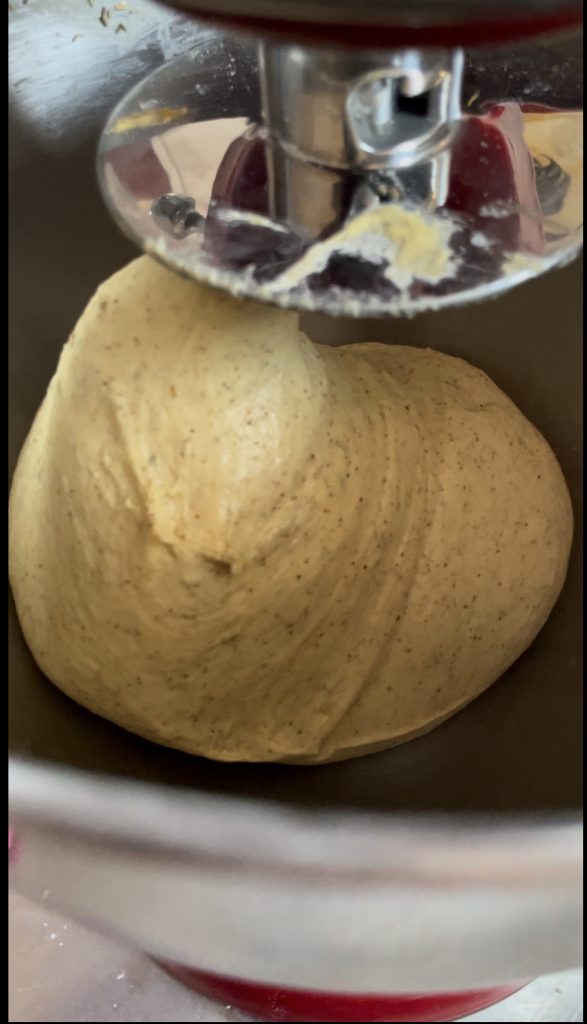
After transferring the dough to an oiled bowl and letting it rest for half an hour, proceed with 3 rounds of folding in the bowl as shown in the images, with half an hour between each round. Seal the dough well at the end of each round of folds. Cover with cling film or a silicone lid and refrigerate for a minimum of 8 hours. I kneaded the dough in the evening, put it in the fridge around 7 PM, and took it out at 10 AM the next day.
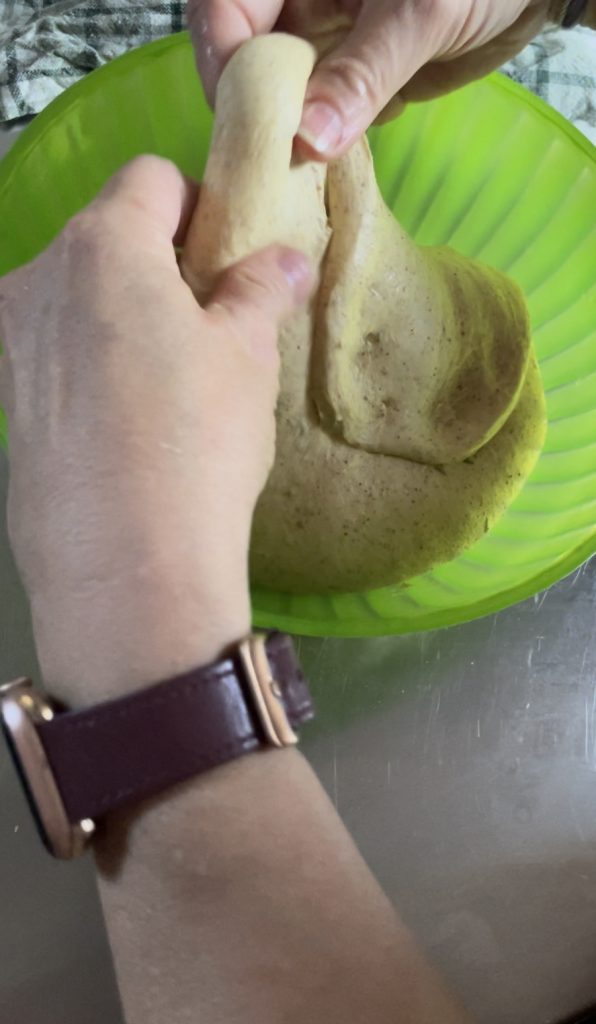
Now begins the slightly more laborious part of the recipe, which requires several spreads to achieve the desired result.
Start by turning the dough onto a lightly floured work surface (or workbench) and gently spread it, trying to stretch it as much as possible without forcing it.

The dough spreading will allow for the lamination, which will give strength and structure to the dough. To do it, fold the dough as in the steps, first like a wallet above and below.

Finish by closing the sides, sealing all gaps well. Cover with a bowl as a dome for an hour.
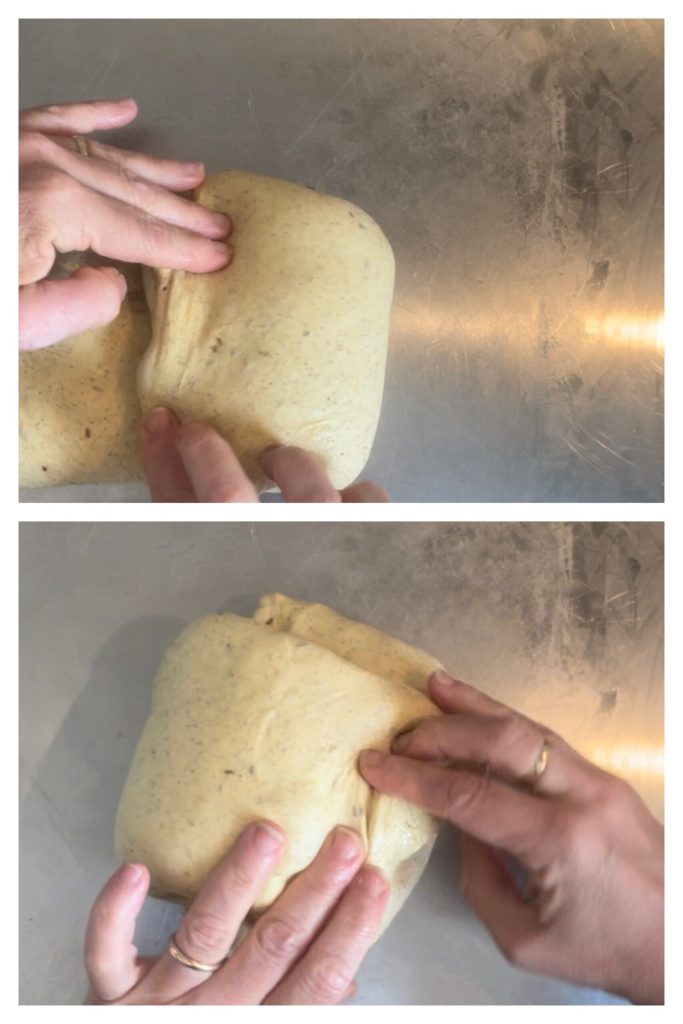
After the required time, make a first spreading, initially on the work surface and then transfer everything onto the baking tray covered with parchment paper and drizzled with oil. Spread very gently with your fingers without forcing the dough. It won’t cover the entire tray. For this, cover it with cling film and a cloth and wait half an hour so it relaxes and is easier to spread.

Once the dough has relaxed, finish spreading it and prepare a brine by emulsifying water and oil in a small bowl or coffee cup.
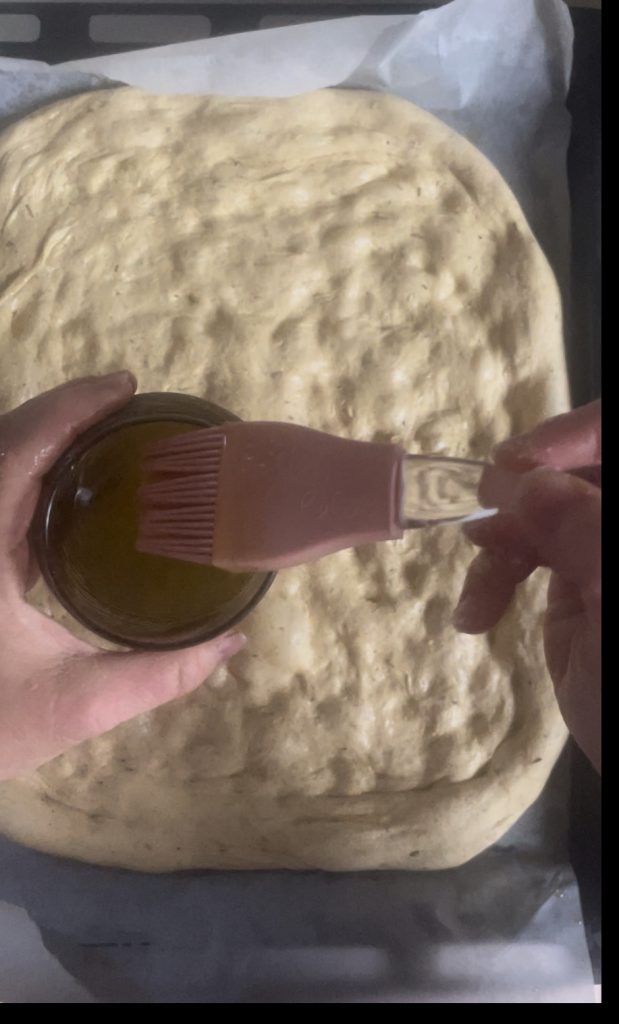
Drizzle the dough with the emulsion and spread it well with a food brush. Cover the focaccia again with cling film and a cloth so the dough absorbs the brine.
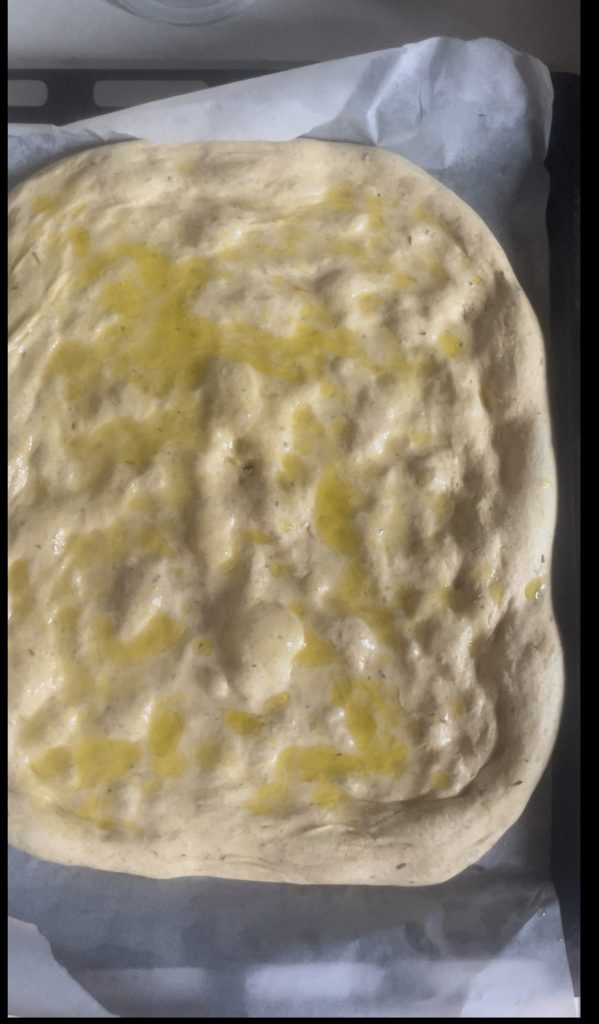
After half an hour, the dough will be soft and workable. Make indentations with your fingertips to create a play of valleys and bumps.
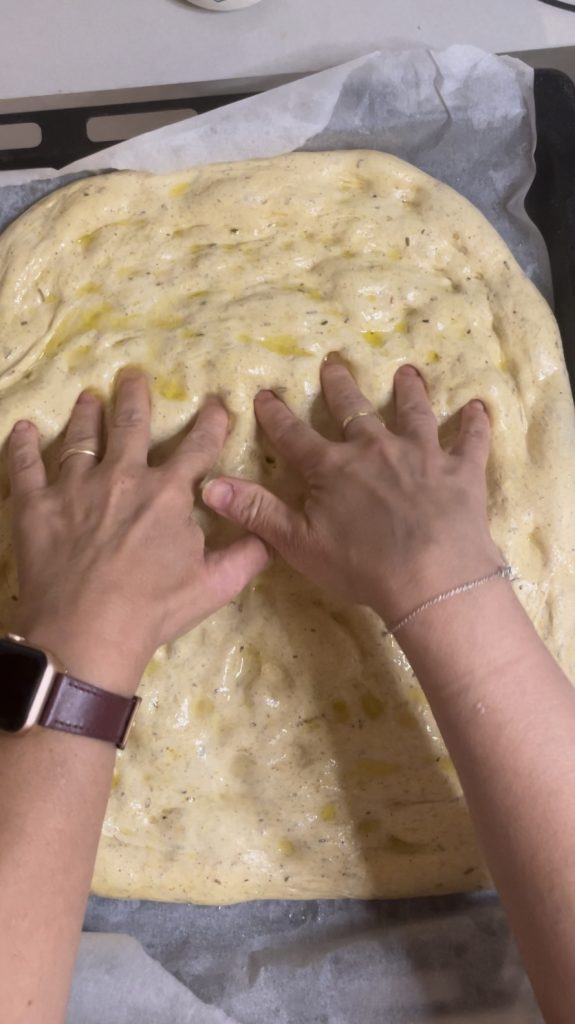
Drizzle with oil, coarse salt, and more rosemary. The dough will finally be ready for the oven!
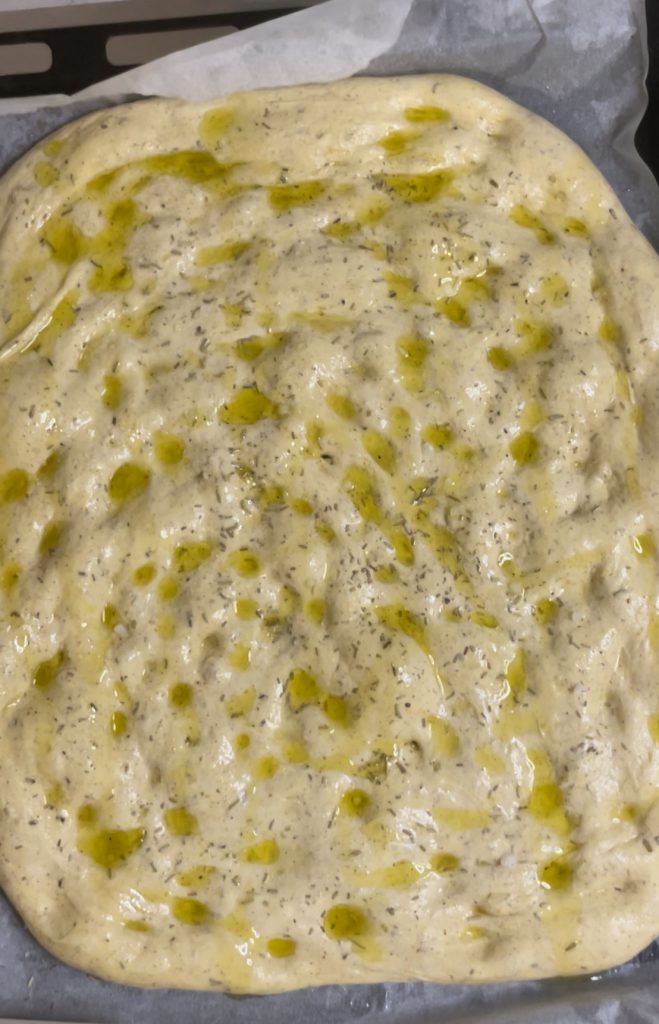
While the dough rises, preheat the oven to 410-430°F (210-220°C) in static mode.
Once it reaches the temperature, put the baking tray inside, either near the bottom or on a baking stone. After 20 minutes, lower the temperature to 356°F (180°C) and continue baking for another 20 minutes.

Remove the pumpkin focaccia with sourdough starter from the oven, let it cool slightly, and then cut it. You’ll be amazed by its crunchiness as well as its taste!

Advice and Variations
For a stronger flavor, you can increase the pumpkin by 20 grams; in that case, my advice is to set aside 20 grams of water and see if it’s necessary or not. You can also try replacing the sourdough starter with 3 grams of dry yeast, but don’t tell my Gino!
The pumpkin focaccia with sourdough starter pairs excellently with savory cured meats and cheeses, but it’s also delicious on its own. On Instagram, I’ve posted a reel explaining the method I used, check it out and let me know what you think! 🙂
The pumpkin focaccia with sourdough starter pairs excellently with savory cured meats and cheeses, but it’s also delicious on its own. On Instagram, I’ve posted a reel explaining the method I used, check it out and let me know what you think! 🙂

